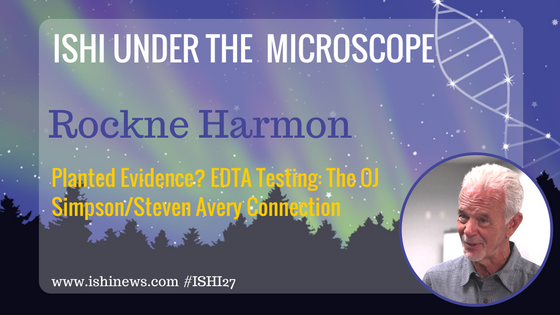The ISHI27 agenda is already filling up with some great talks from amazing speakers! While the forensic community is a tight-knit group, we can always get a little closer, right? With that in mind, we asked our speakers some questions to get to know them a little better outside of their work. We’ve been posting their responses in a feature we like to call Under the Microscope.
Today, we’re chatting with Rockne Harmon, who will be presenting Planted Evidence? EDTA Testing: The OJ Simpson/Steven Avery Connection during the General Sessions on Wednesday, September 28th.
Rockne P. Harmon is currently employed as a consultant to numerous law enforcement agencies dealing with such issues as cold case investigation and other issues related to forensic DNA typing. He is currently an Instructor at U.C. Davis in the Masters in Forensic Science program. He retired in 2007 after a 33 year career as a Senior Deputy District Attorney for Alameda County, California.
He graduated from the United States Naval Academy in 1967 and served four years active duty. He served a combat tour in Vietnam as Officer in Charge of a Navy Swift Boat and received the Purple Heart for wounds received in combat. After his military service he attended the University of San Francisco School of Law and graduated in 1974. He is a Fellow of the American Academy of Forensic Sciences.
He was the prosecutor in a triple murder case that established the general acceptance of conventional serological methods, the precursor to today’s DNA technology.( People v. Lawrence Reilly). As a result of that case he was in a position to assist the forensic science community as it began the implementation of DNA typing soon thereafter.
He has written and lectured extensively on the subject of the admissibility of forensic evidence, particularly DNA evidence. In 1998 he received an award from the FBI Director for his efforts supporting the FBI in their first decade of DNA typing. In 2003 he received the Achievement Award from the International Homicide Investigators’ Association for his work on cold cases.
He was the Chairman of the California District Attorneys’ Association Forensic Science Committee and was on the Advisory Board to the International Homicide Investigators’ Association for many years. At Alameda County he developed a highly successful protocol for solving old or unsolved cases using DNA typing. He was the driving force behind the California Attorney General’s decision to implement familial DNA searching in California that led to the arrest of the “Grim Sleeper” serial killer in 2010.
He was one of the prosecutors in People v. O. J. Simpson.
How did you come to work in the field of forensics/DNA?
By coincidence I was assigned to try a triple murder case that involved conventional serology, the precursor to forensic DNA typing. I conducted an admissibility hearing that established the legal precedent for admissibility of serology. It became a big deal in the forensic community and I was invited to speak at meetings. Soon thereafter forensic DNA hit the horizon and I was invited to participate in many of the seminal meetings concerning DNA, including the first Promega meetings held in Madison.
What is your favorite thing about your job? Why?
My favorite thing is that I don’t have a job because I’m retired. Almost everything I do is pro bono, so I’m free to do whatever I choose. Most of my work efforts involve familial searching or probabilistic genotyping. I really enjoy meeting new people at smaller meetings.
What is the biggest challenge you face in your job?
With respect to making progress on familial searching the biggest challenge is the near complete absence of substantive discussion among prosecutors, law enforcement, and forensic leadership.
What accomplishment are you most proud of relating to forensics/DNA?
Participating in some of the seminal DNA admissibility hearings and compelling California DOJ to implement familial DNA searching with the help and support of Denver DA Mitch Morrissey and many informed California prosecutors.
If you’ve attended ISHI before, what keeps you coming back? If you’ve never attended before, what are you most looking forward to at ISHI27?
I spoke at the first 2 meetings in Wisconsin. Then I spoke periodically over the past 20 years. It is the combination of talks, posters, and people that makes the meeting so important and enjoyable. It is also the mantra “What happens in Scottsdale stays in Scottsdale.”
When you were little, what career did you think you’d have as an adult?
I was having too much fun being a kid to have any firm ideas.
Plus, it changed every time I saw a new movie or read a comic book.
Where do you see the future of forensic science headed?
Technologically the improvements are profound. However law enforcement, bureaucracy, and the legal system continue to be major impediments to widespread use and acceptance of these improvements. Generally speaking, improvements such as familial DNA searching, rapid DNA, MPS and probabilistic genotyping should see more widespread use.
What do you hope the audience learns/takes away from your talk?
That reality tv is entertainment, not reality.
What person would you say has had the biggest influence in your career?
Too many to list, would sound like an Oscar acceptance speech. I owe a lot to many.
If you could time-travel, what year would you go to and why?
1970, Vietnam, senses were heightened, everything was real, you trusted everyone.
Star Wars or Star Trek?
Star Search!
WOULD YOU LIKE TO SEE MORE ARTICLES LIKE THIS? SUBSCRIBE TO THE ISHI BLOG BELOW!
SUBSCRIBE NOW!


